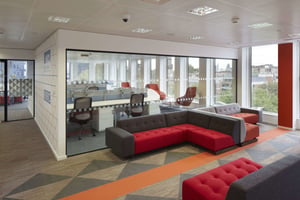As Access and Inclusion Manager for UCL I work closely with our design teams and furniture providers, including JPA, to consider how both the built and internal environment can assist in creating an inclusive environment. So - what’s the deal with furniture and inclusion? Is there a link? What guidance is out there? And how do I approach it?
Yes, there is technical guidance out there in the form of the British Standard BS8300 volumes 1 and 2 (Code of Practice on the design of an accessible and inclusive built environment) which sets out some of the considerations both on furniture and building design. UCL requires all built environment projects to meet these standards.
However, the focus of BS8300 is on disability, whereas the kind of inclusive design approach that UCL is committed to goes beyond access for disabled people. We recognise everyone is an individual and the environment around people should offer choices for people, now and in the future. And yes - the furniture we use in our day to day lives plays an important role in this.
Questions to Ask When Creating an Inclusive Environment
Say, for example, you are choosing a new sofa for a reception area in a busy office block - what are you thinking about?
Are you thinking:
- How easy is it to get up and down from the sofa if you are tall, short, wearing a skirt or dress or if an individual uses crutches or walking aids?
- Can a wheelchair user transfer from their wheelchair to the sofa easily should they want to?
- Does the sofa have wide flat arms that could act as a perch seat for someone?
- Does the sofa contrast with the floor so it is recognisable for someone with low vision?
- Is the material of the seating going to assist with sound absorption in the reception area - creating better acoustics for those with hearing difficulties?
If you are not asking these questions - I would suggest you should be!
Include Everyone In Your Choice of Furniture
When choosing furniture for public spaces, you need to be thinking about all potential users.
In the disability world there is a saying ‘nothing about us, without us’, and that is the way that I like to work here at UCL. I try to do it in a way that does not place responsibility on those affected by an issue to find a solution. Instead, I spend time listening to the users of spaces, taking their views into account, along with good practice guidance and my own theoretical and practical knowledge.
In the case of furniture, the aim is to create an environment that offers choices to as many people as possible.
So why is this important? Good furniture choices have a positive impact on the health and well-being of all employees and customers. Simple concepts such as installing rise and fall desks (also known as sit / stand desks) means that one desk can suit different users, as well as allowing them to alternate between sitting and standing at different points during the day (if they desire), which can bring health benefits for some.
I encourage those using spaces to think about not only the items of furniture they need to use, but also where these items are going to be located in order to reduce the risk of collision for a range of users.
The ask is quite simple: think about inclusion and users when choosing furniture! UCL is still navigating its inclusive environments journey, but staff and students alike are already experiencing the benefits of us doing this.
